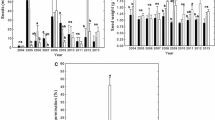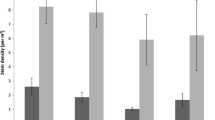Abstract
To assess the canopy seed bank structure of Pinus halepensis, we measured the level of serotiny and the seed bank size and density of trees in unburned stands and post-fire regenerated stands in Israel. We analysed the effects of tree size, tree density and fire history on the level of serotiny. The level of serotiny decreased with an increase in tree height. The high level of serotiny in short trees could be explained by selection to increase regeneration chances after burning at pre-mature age. Also, limitation of long-distance seed dispersal opportunities in short trees may favour high serotiny levels. The level of serotiny was higher in post-fire stands than in unburned stands, suggesting a fast selection for serotiny by fire. Unburned stands had a higher total stand seed density than post-fire regenerated stands, but the proportion of seeds in serotinous cones of the total stand seed density was higher in post-fire regenerated stands. The fact that P. halepensis bears simultaneously serotinous and non-serotinous cones reflects its dual strategy as both a post-fire obligate seeder, mainly from serotinous cones and an early coloniser during fire-free periods, mainly from non-serotinous cones. The relative investment in these strategies is dependent on fire history and varies with tree height. Furthermore, mature brown cones can contribute to post-fire regeneration in case of spring fires, and serotinous cones are known to open partially also in dry spell events. Thus, post-fire regeneration and invasion are strategies, which seem to complement each other.
Similar content being viewed by others
References
Agee J.K. 1998. Fire and pine ecosystems. In: Richardson D.M. (Ed.), Ecology and Biogeography of Pinus. Cambridge University Press, Cambridge, pp. 193–218.
Arianoutsou M. and Ne'eman G. 2000. Post-fire regeneration of natural Pinus halepensis forests in the east Mediterranean basin. In: Ne'eman G. and Trabaud L. (Eds.), Ecology, Biogeography, and Management of Pinus halepensis and P. brutia Forest Ecosystems in the Mediterranean basin. Backhuys Publishers, Leiden, pp. 269–289.
Barbéro M., Loisel R., Quézel P., Richardson D.M. and Romane F. 1998. Pines of the Mediterranean basin. In: Richardson D.M. (Ed.),Ecology and Biogeography of Pinus. Cambridge University Press, Cambridge, pp. 153–170.
Bond W.J. and vanWilgen B.W. 1996. Fire and Plants. Usher M.B., DeAngelis D.L. and Manly B.F.J. (Eds.), Chapman and Hall, London.
Cowling R.M. and Lamont B.B. 1985. Variation in serotiny of three Banksia species along a climatic gradient. Austr. J. Ecol. 10: 345–350.
Critchfield W.A. 1985. The later quaternary history of lodgepole and jack pines. Can. J. For. Res. 15: 749–772.
Daskalakou E.N. and Thanos C.A. 1996. Aleppo pine-Pinus halepensis-postfire regeneration: the role of canopy and soil seed banks. Int. J. Wildland Fire 6: 59–66.
Enright N.J., Marsula R., Lamont B.B. and Wissel C. 1998. The ecological significance of canopy seed storage in fire-prone environments: a model for non-sprouting shrubs. J. Ecol. 86: 946– 959.
Gaudet C.L. and Keddy P.A. 1988. A comparative approach to predicting competitive ability from plant traits. Nature 334: 242–243.
Gauthier S., Bergeron Y. and Simon J.P. 1993. Cone serotiny in jack pine: ontogenetic, positional and environmental effects. Can. J. For. Res. 23: 394–401.
Gauthier S., Bergeron Y. and Simon J.P. 1996. Effects of fire regime on the serotiny level of jack pine. J. Ecol. 84: 539–548.
Grace S.L. and Platt W.J. 1995. Effects of adult tree density and fire on the demography of pregrass stage juvenile longleaf pine (Pinus palustris Mill.). J. Ecol. 83: 75–86.
Greene D.F. and Johnson E.A. 1996. Wind dispersal of seeds from a forest into a clearing. Ecology 77: 595–609.
Keeley J.E. 1994. Seed-germination patterns in fire-prone Mediterranean climate regions. In: Arroyo M.T.K., Zedler P.H. and Fox M.D. (Eds.), Ecology and Biogeography of Mediterranean ecosystems in Chile, California and Australia. Springer, Berlin, pp. 239–273.
Keeley J.E. and Zedler P.H. 1998. Evolution of life histories in pines. In: Richardson D.M. (Ed.), Ecology and Biogeography of Pinus. Cambridge University Press, Cambridge, pp. 219–249.
Keeley J.E., Ne'eman G. and Fotheringham C.J. 1999. Immaturity risk in a fire-dependent pine. J. Med. Ecol. 1: 41–48.
Lamont B.B. 1991. Canopy seed storage and release – what's in a name? Oikos 60: 266–268.
Lamont B.B., Le Maitre D.C., Cowling R.M. and Enright N.J. 1991. Canopy seed storage in woody plants. Bot. Rev. 57: 277–317.
Lanner R.M. 1998. Seed dispersal in Pinus. In: Richardson D.M. (Ed.), Ecology and Biogeography of Pinus. Cambridge University Press, Cambridge, pp. 281–295.
Leone V., Logiurato A. and Saracino A. 1999. Serotiny in Pinus halepensis Mill., recent issues. In: Ne'eman G. and Izhaki I. (Eds.), Abstracts of MEDPINE, International Workshop on Mediterranean Pines. Beit Oren, Israel, 34 p.
Lepart J. and Debussche M. 1991. Invasion processes as related to succession and disturbance. In: Groves R.H. and di Castri F. (Eds.), Biogeography of Mediterranean Invasions. Cambridge University press, Cambridge, pp. 159–177.
Lotan J.E. 1975. The role of cone serotiny in lodgepole pine forests. In: Baumgartner D.M. (Ed.), The Management of Lodgepole pine Ecosystems. Washington State University, Pulman WA, pp. 471–495.
McMaster G.S. and Zedler P.H. 1981. Delayed seed dispersal in Pinus torreyana (Torrey pine). Oecologia 51: 62–66.
Nathan R. and Ne'eman G. 2000. Serotiny, seed dispersal and seed predation in Pinus halepensis. In: Ne'eman G. and Trabaud L. (Eds.), Ecology, Biogeography, and Management of Pinus halepensis and P. brutia Forest Ecosystems in the Mediterranean basin. Backhuys Publishers, Leiden, pp. 105–118.
Nathan R., Safriel U.N., Noy-Meir I. and Schiller G. 1999. Seed release without fire in Pinus halepensis, a Mediterranean serotinous wind-dispersed tree. J. Ecol. 87: 659–669.
Nathan R., Safriel U.N., Noy-Meir I. and Schiller G. 2000. Spatiotemporal variation in seed dispersal and recruitment near and far from Pinus halepensis trees. Ecology 81: 2156–2169.
Nathan R., Horn H.S., Chave J. and Levin S.A. 2001a. Mechanistic models for tree seed dispersal by wind in dense forests and open landscapes. In: Levey D.J., Silva W.R. and Galetti M. (Eds.), Seed Dispersal and Frugivory: Ecology, Evolution and Conservation. CAB International, Oxfordshire, UK, pp. 69–82.
Nathan R., Safriel U.N. and Noy-Meir I. 2001b. Field validation and sensitivity analysis of a mechanistic model for tree seed dispersal by wind. Ecology 82: 374–388.
Naveh Z. 1974. Effects of fire in the Mediterranean region. In: Kozlowsky T.T. and Ahlgren C.E. (Eds.), Fire and Ecosystems. Academic Press, New York, pp. 401–434.
Ne'eman G. and Izhaki I. 1999. The effect of stand age and microhabitat on soil seed banks in Mediterranean Aleppo pine forests after. Plant Ecol. 144: 115–125.
Oke T.R. 1987. Boundary layer climates, 2nd ed. Methuen, London.
Panetsos K.P. 1981. Monograph of Pinus halepensis and Pinus brutia. Annales Forestales (Zagreb) 9: 39–77.
Perry D.A. and Lotan J.E. 1979. A model of fire selection for serotiny in lodgepole pine. Evolution 33: 958–968.
Quézel P. 2000. Taxonomy and biogeography of Mediterranean pines (Pinus halepensis and P. brutia). In: Ne'eman G. and Trabaud L. (Eds.), Ecology, Biogeography, and Management of Pinus halepensis and P. brutia Forest Ecosystems in the Mediterranean basin. Backhuys Publishers, Leiden, pp. 1–12.
Richardson D.M. 2000. Mediterranean pines as invaders in the Southern Hemisphere. In: Ne'eman G. and Trabaud L. (Eds.), Ecology, Biogeography, and Management of Pinus halepensis and P. brutia Forest Ecosystems in the Mediterranean basin. Backhuys Publishers, Leiden, pp. 131–142.
Roitemberg D. and Ne'eman G. 1999. Post-fire seed dispersal in Pinus halepensis. In: Ne'eman G. and Izhaki I. (Eds.), Abstracts of MEDPINE, International Workshop on Mediterranean Pines. Beit Oren, Israel, p. 46.
Saracino A., Pacella R., Leone V. and Borghetti M. 1997. Seed dispersal and changing seed characteristics in a Pinus halepensis Mill. Forest after fire. Plant Ecol. 130: 13–19.
Schiller G., Conckle M.T. and Grunwald C. 1985. Local differentiation among Mediterranean populations of Aleppo pine in their isoenzymes. Silvae Genetica 35: 11–19.
Schiller G., Ne'eman G. and Korol L. 1997. Post-fire vegetation dynamics in a native Pinus halepensis Mill. forest on Mt. Carmel Israel. Isr. J. Plant Sci. 45: 297–308.
Shmida A., Ne'eman G., Goubitz S. and Lev-Yadun S. 2000. Sexual allocation and gender segregation in Pinus halepensis. In: Ne'eman G. and Trabaud L. (Eds.), Ecology, Biogeography, and Management of Pinus halepensis and P. brutia Forest Ecosystems in the Mediterranean basin. Backhuys Publishers, Leiden, pp. 91–104.
Smith H., Casal J.J. and Jackson G.M. 1990. Reflection signals and the perception by phytochrome of the proximity of neighbouring vegetation. Plant Cell and Environment 13: 73–78.
Teich A.H. 1970. Cone serotiny and inbreeding in natural populations of Pinus banksiana and Pinus contorta. Can. J. Bot. 48: 1805–1809.
Thanos C.A. and Daskalakou E.N. 2000. Reproduction in Pinus halepensis and P. brutia. In: Ne'eman G. and Trabaud L. (Eds.), Ecology, Biogeography, and Management of Pinus halepensis and P. brutia Forest Ecosystems in the Mediterranean basin. Backhuys Publishers, Leiden, pp. 79–90.
Trabaud L. 1987. Fire and survival traits of plants. In: Trabaud L. (Ed.), The Role of Fire in Ecological Systems. SPB Academic Publishing, The Hague, pp. 65–89.
Trabaud L. 1991. Is fire an agent favoring plant invasions? In: Groves R.H. and di Castri F. (Eds.), Biogeography of Mediterranean Invasions. Cambridge University Press, Cambridge, pp. 179–189.
Trabaud L. 2000. Post-fire regeneration of natural Pinus halepensis forests in the west Mediterranean. In: Ne'eman G. and Trabaud L. (Eds.), Ecology, Biogeography, and Management of Pinus halepensis and P. brutia Forest Ecosystems in the Mediterranean basin. Backhuys Publishers, Leiden, pp. 257–268.
Weinstein-Evron M. and Lev-Yadun S. 2000. Palaeoecology of Pinus halepensis in Israel in the light of palaeoecological and archeobotanical data. In: Ne'eman G. and Trabaud L. (Eds.), Ecology, Biogeography, and Management of Pinus halepensis and P. brutia Forest Ecosystems in the Mediterranean basin. Backhuys Publishers, Leiden, pp. 119–130.
Zar J.H. 1984. Biostatistical Analysis. Prentice-Hall Inc., New Jersey.
Zedler P. 1995. Fire frequency in southern California shrublands: biological effects and management options. In: Keeley J.E. and Scott T. (Eds.), Brushfires in California Wildlands: Ecology and Resource Management. International Association of Wildland Fire, Fairfield WA, pp. 101–112.
Author information
Authors and Affiliations
Corresponding author
Rights and permissions
About this article
Cite this article
Goubitz, S., Nathan, R., Roitemberg, R. et al. Canopy seed bank structure in relation to: fire, tree size and density. Plant Ecology 173, 191–201 (2004). https://doi.org/10.1023/B:VEGE.0000029324.40801.74
Issue Date:
DOI: https://doi.org/10.1023/B:VEGE.0000029324.40801.74




